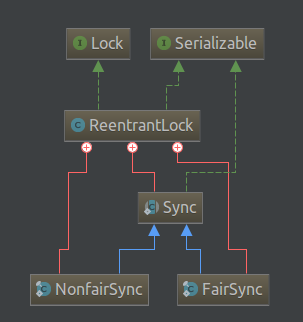ReentrantLock-重入锁
首先让我们先看下 ReentrantLock 的类结构如下图所示:

从图中我们可以看出 ReentrantLock 实现 Lock 接口,同时内部类 Sync 是 AQS 的子类;而 Sync 又有两个子类 NonfairSync 和 FairSync 分别对应非公平和公平锁两种策略。
构造
public ReentrantLock() {
sync = new NonfairSync();
}
复制代码
public ReentrantLock(boolean fair) {
sync = fair ? new FairSync() : new NonfairSync();
}
复制代码
ReentrantLock 默认采用非公平的策略,也可以在构造的时候指定是否公平的策略。
非公平锁
非公平锁是指在竞争获取锁的过程中,有可能后来者居上
lock() 获取锁
static final class NonfairSync extends Sync {
private static final long serialVersionUID = 7316153563782823691L;
/**
* Performs lock. Try immediate barge, backing up to normal
* acquire on failure.
*/
final void lock() {
// CAS 设置 state 值为 1
if (compareAndSetState(0, 1))
// CAS 成功则说明获取到锁, 此时将当前线程设置为独占模式下锁对象的持有者
setExclusiveOwnerThread(Thread.currentThread());
else
// CAS 失败
// 可能是同一线程再次获取锁
// 也可能是不同线程获取锁
acquire(1);
}
protected final boolean tryAcquire(int acquires) {
// 调用父类 sync
return nonfairTryAcquire(acquires);
}
}
复制代码
final boolean nonfairTryAcquire(int acquires) {
final Thread current = Thread.currentThread();
int c = getState();
if (c == 0) {
// 此时说明已有线程释放了锁
// 有可能是同步队列里阻塞的线程被唤醒时尝试获取锁
if (compareAndSetState(0, acquires)) {
// CAS 成功则说明获取到锁, 此时将当前线程设置为独占模式下锁对象的持有者
setExclusiveOwnerThread(current);
return true;
}
}
else if (current == getExclusiveOwnerThread()) {
// 说明同一线程再次获取锁
// state 加 1
int nextc = c + acquires;
if (nextc < 0) // overflow
throw new Error("Maximum lock count exceeded");
setState(nextc);
return true;
}
return false;
}
复制代码
获取锁的过程如下 :
- 通过 CAS 操作, 设置 state = 1
- 若 CAS 操作成功,则将当前线程设置为独占模式锁对象的持有者
- 若 CAS 操作失败, 最终会调用 sync 的方法 nonfairTryAcquire; 此时说明可能是同一线程再次尝试获取锁,也有可能是其他线程尝试获取锁
- 若当前 state == 0, 继续执行前两步操作
- 若当前 state != 0, 则判断当前线程是否为锁的持有者;若判断成立,则对 state + 1
unlock() - 释放锁
非公平锁的释放调用的是父类 sync 的 tryRelease 方法
protected final boolean tryRelease(int releases) {
// state 减一操作
int c = getState() - releases;
if (Thread.currentThread() != getExclusiveOwnerThread())
// 当前线程不是当前锁的持有者时抛出异常
throw new IllegalMonitorStateException();
boolean free = false;
if (c == 0) {
// 只有 state == 0 时 才是真正完成锁的释放
free = true;
// 将锁的持有者清空
setExclusiveOwnerThread(null);
}
setState(c);
return free;
}
复制代码
从释放锁的实现可以看出,获取锁与释放锁的操作是对等的,譬如下方伪代码:
ReentrantLock lock = new ReentrantLock();
public void do () {
lock.lock();
try {
do();
// 退出递归
} finally {
lock.unlock();
}
}
复制代码
公平锁
公平锁是指获取锁的顺序完全符合请求时间的顺序,也就是先到先得
lock() - 获取锁
接下来我们下公平锁与非公平锁在获取锁时有什么不同
protected final boolean tryAcquire(int acquires) {
final Thread current = Thread.currentThread();
int c = getState();
if (c == 0) {
// 不同于非公平锁操作,公平锁多了个判断条件 hasQueuedPredecessors
if (!hasQueuedPredecessors() &&
compareAndSetState(0, acquires)) {
setExclusiveOwnerThread(current);
return true;
}
}
else if (current == getExclusiveOwnerThread()) {
int nextc = c + acquires;
if (nextc < 0)
throw new Error("Maximum lock count exceeded");
setState(nextc);
return true;
}
return false;
}
复制代码
public final boolean hasQueuedPredecessors() {
// The correctness of this depends on head being initialized
// before tail and on head.next being accurate if the current
// thread is first in queue.
Node t = tail; // Read fields in reverse initialization order
Node h = head;
Node s;
// h != t 说明同步队列已有等待的节点
// s = h.next == null 这个有点没明白; head 的后置为空应该就是 head == tail 吧
// s.thread != Thread.currentThread 是判断当前线程是不是同步队列的首个阻塞线程 如果是是允许获取到锁的
return h != t &&
((s = h.next) == null || s.thread != Thread.currentThread());
}
复制代码
Queries whether any threads have been waiting to acquire longer than the current thread. 复制代码
hasQueuedPredecessors 方法主要实现的是查找是否有等待时间超过当前线程的其他线程, 公平锁也就是通过该方法保证获取锁的有序性。
正文到此结束
热门推荐
相关文章
Loading...











![[HBLOG]公众号](https://www.liuhaihua.cn/img/qrcode_gzh.jpg)

